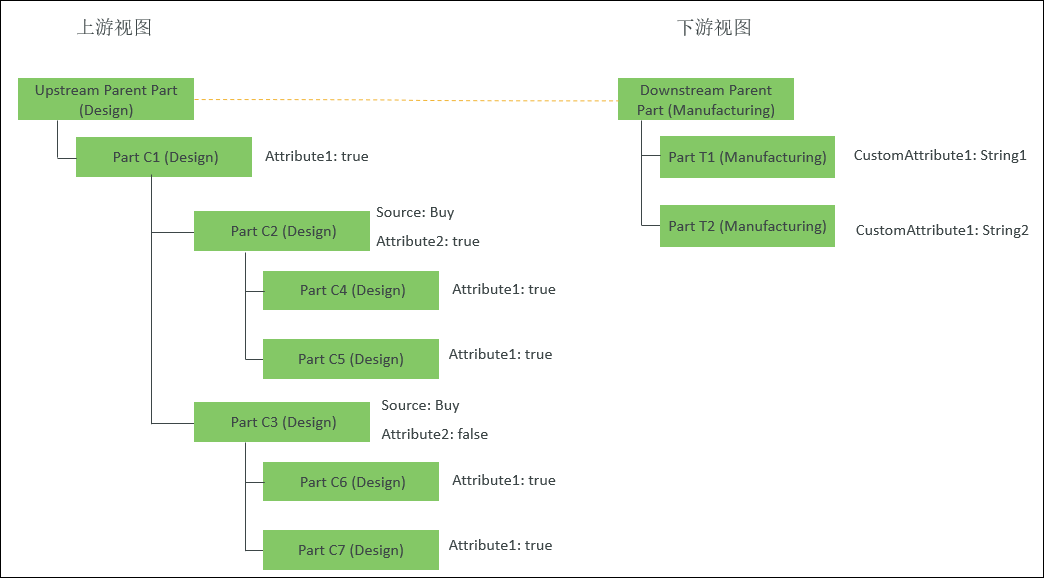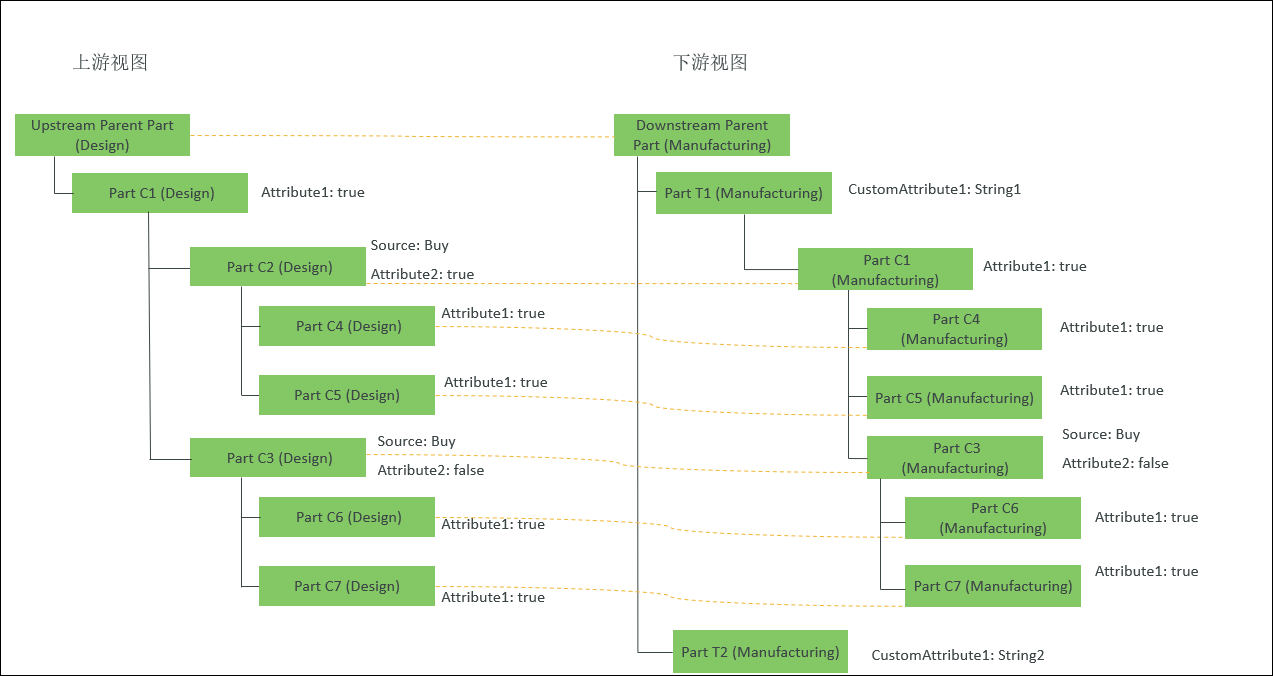用例 9:通过基于两个属性跳过部件来生成下游结构
假设 BOM 变换器中存在以下结构:

• Upstream Parent Part (Design) 与 Downstream Parent Part (Manufacturing) 之间存在对等链接。
• Part C1 (Design)、Part C4 (Design)、Part C5 (Design)、Part C6 (Design) 和 Part C7 (Design) 的部件使用关系属性 Attribute1 均设为 true。
Attribute1 是布尔型属性。在 Windchill 中,此属性的值为 Yes 和 No。true 和 false 分别等同于 Yes 和 No。 |
• 结构中所有部件的部件类型均为 wt.part.WTPart。
1. 访问位于 Windchill/codebase/com/ptc/core/foundation/associativity 的 associativity.properties.xconf 文件。
2. 在 Windchill/codebase/com/ptc/core/foundation/associativity 文件中添加以下重构规则:
<Property name="com.ptc.windchill.associativity.reconciliation.addusage.wt.part.WTPart" multivalued="," default=""/>
<AddToProperty name="com.ptc.windchill.associativity.reconciliation.addusage.wt.part.WTPart" value="transformoption=newPart"/>
<AddToProperty name="com.ptc.windchill.associativity.reconciliation.addusage.wt.part.WTPart" value="targetType=wt.part.WTPart"/>
<AddToProperty name="com.ptc.windchill.associativity.reconciliation.addusage.wt.part.WTPart" value="attributeMapping.rule1=Attribute1:true:CustomAttribute1:String1"/>
<AddToProperty name="com.ptc.windchill.associativity.reconciliation.addusage.wt.part.WTPart" value="skipAttribute.Source=Buy"/>
<AddToProperty name="com.ptc.windchill.associativity.reconciliation.addusage.wt.part.WTPart" value="skipAttribute.Attribute2=true"/>
<AddToProperty name="com.ptc.windchill.associativity.reconciliation.addusage.wt.part.WTPart" value="doAndValidationForAttr=true"/>
对上游选定部件启动  操作后,Windchill 系统将遍历选定部件下方的结构。此配置可确保: 操作后,Windchill 系统将遍历选定部件下方的结构。此配置可确保:如果 Windchill 系统在上游结构中检测到部件使用关系属性 Attribute1 设为 true 的部件,则会将检测到的部件变换到下游结构中部件使用关系属性 CustomAttribute1 设为 String1 的部件之下。 该部件被转换为新部件。 如果 Windchill 系统在上游结构中检测到部件使用关系属性 Attribute2 设为 true 且属性 Source 设为 Buy 的部件,则会跳过该部件,而不会将其添加到下游结构中。但是,将遍历检测到的部件下方的结构。 |
3. 选择 Upstream Parent Part (Design,然后单击中间窗格工具栏中的  。
。
 。
。4. BOM 变换器中会显示下列结构:

• Part C2 (Design) 会被跳过,因为该部件满足以下特性中设置的条件。 ◦ <AddToProperty name="com.ptc.windchill.associativity.reconciliation.addusage.wt.part.WTPart" value="skipAttribute.Source=Buy"/> ◦ <AddToProperty name="com.ptc.windchill.associativity.reconciliation.addusage.wt.part.WTPart" value="skipAttribute.Attribute2=true"/> ◦ <AddToProperty name="com.ptc.windchill.associativity.reconciliation.addusage.wt.part.WTPart" value="doAndValidationForAttr=true"/> 但是,系统会遍历其下方的结构。 • Part C1 (Design)、Part C4 (Design)、Part C5 (Design)、Part C6 (Design) 和 Part C7 (Design) 的部件使用关系属性 Attribute1 均设为 true。因此,这些部件将作为新部件添加到 Part T1 (Manufacturing) 之下。Part T1 (Manufacturing) 的部件使用关系属性 CustomAttribute1 设为 String1。 • 不会在 Part T2 (Manufacturing) 之下添加任何部件。这是因为,该部件的部件使用关系属性 CustomAttribute1 设为 String2。 |